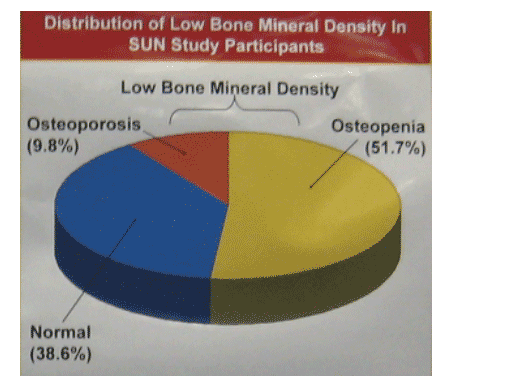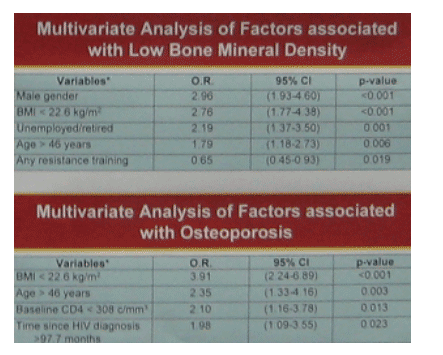 |
 |
 |
| |
SUN Study: 10% Osteoporosis, 51% Osteopenia
|
| |
| |
Reported by Jules Levin
CROI, Feb 2007, Los Angeles
Factors Associated with Low Bone Mineral Density in a Large Cohort of HIV-infected US Adults: Baseline Results from the SUN Study
Et Overton*1, K Mondy1, T Bush2, L Conley2, E Kojic3, K Henry4, J Hammer5, K Wood6, K Lichtenstein7, J Brooks2, and SUN Study Investigators
1Washington Univ Sch of Med, St Louis, MO, US; 2CDC, Atlanta, GA, US; 3The Miriam Hosp, Providence, RI, US; 4HIV Prgm, Hennepin County Med Ctr, Univ of Minnesota, Minneapolis, US; 5Denver Infectious Disease Consultants, Rose Med Ctr, CO, US; 6Cerner Corp, Vienna, VA, US; and 7Univ of Colorado Hlth Sci Ctr, Denver, US
Background: Low bone mineral density (BMD) is a common metabolic complication associated with HIV infection. With increasing survival in the era of HAART, there is continued interest in the factors influencing low BMD in HIV-infected individuals.
Methods: The SUN Study prospectively follows a cohort of HIV-infected patients at clinics in Denver, Minneapolis, Providence, and St. Louis. At baseline, DEXA bone densitometry and body composition, clinical data, and fasting laboratory values were obtained on all subjects. Results were compared to persons from the National Health and Nutrition Examination Study III (NHANES) matched for age, race, gender, and BMI. 625 HIV+ subjects were matched to the NHANES cohort: mean age 41; 135 women, 490 men; 378 caucasians, 173 African-Americans, 61 Hispanics; mean BMI: 26.4 kg/m2; 466 were on HAART; 74 were ART-naive.
Results:

Data were available for 562 matched pairs. Participants had a mean age of 41.0 years, 22% were female, and 27% were African American. Among SUN subjects, 79% were currently on HAART and 60% had an undetectable HIV viral load. Osteopenia (T-score -1.0 to -2.5) and osteoporosis (T-score ≦ -2.5) were identified in 262 (47%) and 59 (11%) subjects, respectively. In multivariate analyses, low BMD (T-score ≦ -1.0) was associated with male gender (OR 2.96, p<0.001), older age (>46 yrs, OR 1.79, male gender, unemployment (OR 2.19), lower body mass index <22.6 kgm2: OR 2.76, p<0.001), any resistance training: OR: 0.65, p=0.019).
Osteoporosis in multivariate analyses was associated with low BMI (<22.6 kg/m2, OR: 3.91, p<0.001), older age (>46 yrs, OR: 2.35, p=0.003), baseline CD4 <308 (OR:2.10, p=0.013), time since HIV diagnosis >97.7 months (OR: 1.98, p=0.023).

When compared to the NHANES cohort, the SUN Study cohort had significantly lower mean T-scores at the femoral neck (-0.77 vs -0.36, p ≦0.01). At this site, the prevalence of low BMD was higher in the SUN Study cohort (51.7% vs 29.1%). Osteoporosis was present in 9.8% of HIV+ vs 1.0% of the NHANES cohort.
In the HAART era, low BMD remains a significant complication of HIV infection, more prevalent than found in the general population. In this large cohort of HIV-infected persons, the majority of whom are virologically controlled, the ramifications of low BMD will become a concern as they age. HIV- and ART-related factors that may affect BMD loss warrant longitudinal study.
Longer duration of time since HIV diagnosis and lower baseline CD$ counts in combination with older age and lower BMI may serve as useful markers for aggressive evaluation of BMD with DEXA scanning.
The SUN Study will provide longitudinal data to determine the evolution of BMD in HIV+ subjects and the role of ART and evaluate the development of fragility fractures.
Poster 837, "Initiation of ART Is Associated with Bone Loss Independent of the Specific ART Regimen. The Results of ACTG A5005s".
In A5005s, the metabolic substudy of AIDS Clinical Trials Group (ACTG) 384, whole-body DEXA scans were performed at entry and every 16 weeks thereafter in 157 subjects. Participants were randomized to receive nelfinavir (NFV), efavirenz (EFV), or both drugs combined with open-label zidovudine (AZT) and lamivudine (3TC) or didanosine (ddI) and stavudine (4dT) (NRTI groups). Percentage change in total bone mineral content was the primary outcome variable.
After the initiation of ART, there was a small but statistically significant decrease in total bone mineral content at 16 weeks (median: -0.44%, IQR -1.96 to 1.07%, p = 0.02). Total bone mineral content continued to decrease. At 48 weeks, the decrease was 1.02% (IQR -3.63 to 1.24%, p <0.01), while at 96 weeks, the decrease was 2.25% (IQR -4.75 to 0.35%, p <0.01). Even though the decline in total bone mineral content in the EFV group was slightly less using a mixed models analysis limited to participants remaining on original treatment, the difference between the NFV and EFV groups was not statistically significant (p = 0.08), nor was the effect of nucleoside reverse transcriptase inhibitor (NRTI) assignment (p = 0.60). Higher baseline CD4 cell count was associated with a slower decline in total bone mineral content after ART initiation (p = 0.002). There was some evidence of both baseline CD4 count & HIV RNA being predictive of changes in bone mineral content. There were significant correlations with changes to week 64 in BMC and marginally significant correlations with changes to week 16 for both measures.
Baseline total bone mineral content correlated weakly with HDL cholesterol (R = -0.24, p <0.01) and percentage of free testosterone (R = 0.26, p <0.01), and a marginally significant correlation between TBMC and total cholesterol (R=-0.15, p=0.08) but using multiple regression analysis percent of free testosterone remained statistically significant (p<0.01) but both HDL and total cholesterol were non-significant.. CD4 and HIV RNA levels were not associated with baseline total bone mineral content. Correlations between changes in total bone mineral content and other metabolic parameters were generally not significant.
The authors concluded:
The start of ART was associated with a modest but statistically significant bone loss that was independent of the regimen (NFV, EFV) used. These changes are greater than expected in a population of this age. The amount of bone loss after ART start was greater in patients with lower CD$ at baseline. The total BMD changes were similar to the changes in TBMC although slightly smaller in magnitude. These findings suggest that the treatment effect of ART on bone is not a direct toxic effect but might be mediated through the antiviral or immunological changes associated with the initiation of treatment.
|
| |
|
 |
 |
|
|